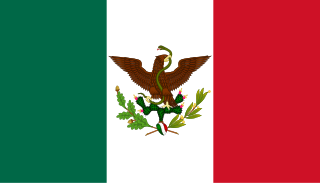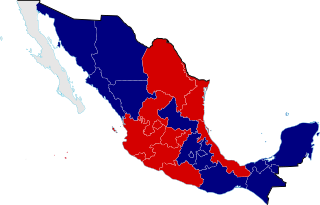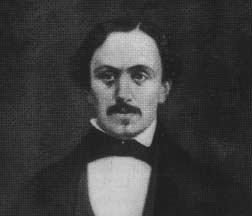
Miguel Gregorio de la Luz Atenógenes Miramón y Tarelo, known as Miguel Miramón, was a Mexican conservative general and politician. He served as anti-constitutional interim conservative President of Mexico in opposition to the constitutional president, Benito Juárez of the Liberal Party. He was one the youngest rulers and the first not born during Spanish colonial rule.

Félix María Zuloaga Trillo was a Mexican general and a Conservative leader in the War of Reform. In the late 1850s and early 1860s, Zuloaga served as unconstitutional interim conservative president of Mexico in opposition to the constitutional president Benito Juárez of the Liberal Party.

Juan Bautista Ceballos was interim president of Mexico from 6 January to 8 February 1853. He was a moderate Liberal.

José Mariano de Salas was a Mexican general and politician who served twice as interim president of Mexico. He was also a member of the executive triumvirate of the Second Mexican Empire that invited Maximilian of Habsburg to take the throne.

Anastasio Bustamante y Oseguera was president of Mexico three times, from 1830 to 1832, from 1837 to 1839 and from 1839 to 1841. A Conservative, he first came to power by leading a coup against President Vicente Guerrero. Bustamante was deposed twice and exiled to Europe both times.

The Second Federal Republic of Mexico is the name given to the second attempt to achieve a federalist government in Mexico. Officially called the United Mexican States, a federal republic was implemented again on August 22, 1846 when interim president José Mariano Salas issued a decree restoring the 1824 constitution. Like the Mexican Empire, the First Federal Republic and the Centralist Republic it was a chaotic period, marked by political instability that resulted in several internal conflicts. Mexico's loss of the war with the United States saw half the territory Mexico claimed become part of the United States. Even though Antonio López de Santa Anna played a major role in much of this history, he returned to the presidency yet again, selling northern territory coveted by the United States contiguous to territory it just gained in the Treaty of Guadalupe Hidalgo. The sale of the Mesilla Valley was for many the final straw, and liberals promulgated of the Plan of Ayutla, calling for the overthrow of Santa Anna. Santa Anna went into exile and the liberals set about implementing their vision of Mexico.

The Battle of Silao took place on August 10, 1860 in the vicinity of Silao in Guanajuato state, Mexico, between elements of the liberal army, under the command of General Jesus Gonzalez Ortega and Ignacio Zaragoza with a force of 8,000 men and elements of the conservative army commanded General Miguel Miramon by commanding an army of 3,282 during the War of Reform. The battle was a liberal victory. General Miguel Miramon was almost captured but escaped in the disorder caused by the Republican artillery, abandoning artillery, ammunition and weapons.

Jesús González Ortega was a military man and Mexican politician; governor of Zacatecas and actively participated next to Benito Juárez in the War of Reform and during the French intervention in Mexico. He is notable for defending the city of Puebla from the French army March 16, 1863 to May 16, 1863. .

Juan Díaz Covarrubias was a Mexican writer and poet of liberal ideology. He was one of the Martyrs of Tacubaya who were executed during the War of the Reform in Mexico.
The Battle of Atenquique took place on 2 July 1858, during the Reform War, in the vicinity of the canyon Atenquique near the Nevado de Colima in the state of Jalisco, Mexico. The conflict was between elements of the liberal army, under General Santos Degollado, and conservative troops, commanded by General Miguel Miramón. The battle caused heavy losses for both sides. Some consider the result undecided, although most historians qualify it as a win with a clear advantage for conservatives: Miramón's troops obtained control of the state of Jalisco. Additionally, Degollado became known as the Hero of the Defeats, for his troops' constant failures.
The Battle of Ahualulco took place on 29 September 1858 during the War of Reform, near the town of Ahualulco in the state of San Luis Potosí, Mexico, between elements of the liberal army, commanded by the Generals Santiago Vidaurri, Juan Zuazua and Francisco Naranjo and conservative army troops commanded by General Miguel Miramón and Leonardo Márquez. The victory went to the conservatives. The liberals suffered 672 casualties and 91 prisoners. It is considered by some to be one of the most brilliant triumphs of Miramón.
The battle of Tlatempa took place on July 5, 1859 in the vicinity of Zacatlán in the state of Puebla, Mexico, between elements of the liberal army, under General Juan N. Mendez and conservative elements of the army commanded by General Carlos Oronoz who was the commander Zacatlán military during the War of Reform. The battle ended as liberal victory, leaving in a very compromising situation to General Miramon because this was amagado the south with the forces of Ignacio Zaragoza, in the north by Jesus Gonzalez Ortega and from the east by Santos Degollado.
The Battle of Estancia de las Vacas took place on November 13, 1859 in the vicinity of Estancia Cows in the state of Querétaro, Mexico, between elements of the liberal army, under General Santos Degollado and elements of the conservative army commanded by General Miguel Miramón during the Reform War. The victory corresponded to the conservative side that won despite the Liberals were doubled in number.
The Battle of Loma Alta took place on April 24, 1860 in the vicinity of Loma Alta in the state of Zacatecas, Mexico, between elements of the liberal army of the National Guard of San Luis Potosí and Zacatecas, under General Jose Lopez Uraga and elements of the conservative army commanded by General Romulo Diaz De La Vega during the War of Reform.
The Battle of Peñuelas took place on June 15, 1860 in the vicinity of Penuelas in the state of Zacatecas, Mexico, between elements of the liberal army, under the command of Gen. Jesus Gonzalez Ortega and elements of the conservative army commanded by General Silverio Ramirez during the War of Reform. The battle ended as liberal victory, leaving in a very compromising situation Miramon because this was amagado the south with the forces of Ignacio Zaragoza, in the north by Jesus González Ortega and from the east by Santos Degollado.

The Battle of Calpulalpan took place on December 22, 1860 during the War of Reform in the vicinity of the community of San Miguel de la Victoria in the municipality of Jilotepec de Abasolo in the State of Mexico, Mexico. It would be the last battle of the War of Reform (1858-1860).
The Battle of Tacubaya took place on 11 April 1859 near the ancient village of Tacubaya in today's Federal District, Mexico City, Mexico, between elements of the liberal army, under General Santos Degollado and elements of the conservative army commanded by General Leonardo Marquez during the War of Reform. The victory corresponded to the preservative side, generating heavy casualties on both sides. After the battle General Miramon ordered Marquez to shoot the chiefs and officers Liberals captured in defeat, including the head of the Army Medical Corps was, as well as other liberal doctors, is why Leonardo Marquez know him as the Tiger of Tacubaya.
The Battle of Salamanca took place between the 9th and the 10th March 1858, in Salamanca, during the War of Reform. Elements of the liberal army, under General Anastasio Parrodi, fought Generals Leandro Valle, Santos Degollado, and Mariano Moret, and conservative elements of the army commanded by General Luis G. Osollo. Osollo's army had some 5,000 men, including Generals Miguel Miramón and Tomas Mejia Francisco Garcia Casanova. The victory corresponded to the conservative side, and was the first major liberal defeat.
The Battle of Guadalajara (1858) took place on 14 December 1858 in the vicinity of La Hacienda de Atequiza, near the city of Guadalajara in the state of Jalisco, Mexico, during Reform War. Between elements of the liberal army, under General Santos Degollado, and elements of the conservative army commanded by Generals Miguel Miramón, Leonardo Márquez, Marcelino Cobos, the victory went to the conservative side. The conservatives attacked the ranch of San Miguel, near Poncitlán, Jalisco, where the battle took place. By the end of the battle, the conservatives had gained great quantities of weapons and other war materials. Afterwards, Miramón sent orders to shoot the captured liberal officers.
The Battle of Loma de las Ánimas took place on November 1, 1859 in the vicinity of Loma de las Animas in the state of Guanajuato, Mexico, between elements of the liberal army of the First Light Battalion, under the command of general Doubled Manuel and Santos Degollado and elements of the conservative army commanded by General Jose Maria Alfaro during the War of Reform. The battle ended as a Liberal victory.
















